 USA 355 submersibles (1917-45)
USA 355 submersibles (1917-45)WW2 US submarines:
O class | R class | S class | T class | Barracuda class | USS Argonaut | Narwhal class | USS Dolphin | Cachalot class | Porpoise class | Salmon class | Sargo class | Tambor class | Mackerel class | Gato class | Balao class | Tench classThe US Navy submarines (Submersibles*) contribution to the war are certainly greater than Battleships, and on par with the aircraft carriers and LSTs in helping turning the tide of the war in 1942. In the Pacific, they were instrumental in the defeat of Japan, using the same tactics as German U-Boats but with much more success as the IJN was late to implement efficient ASW tactics. When this error was realized it was too late already: Immense quantities of vital supplies for the Japanese industry has been sunken.
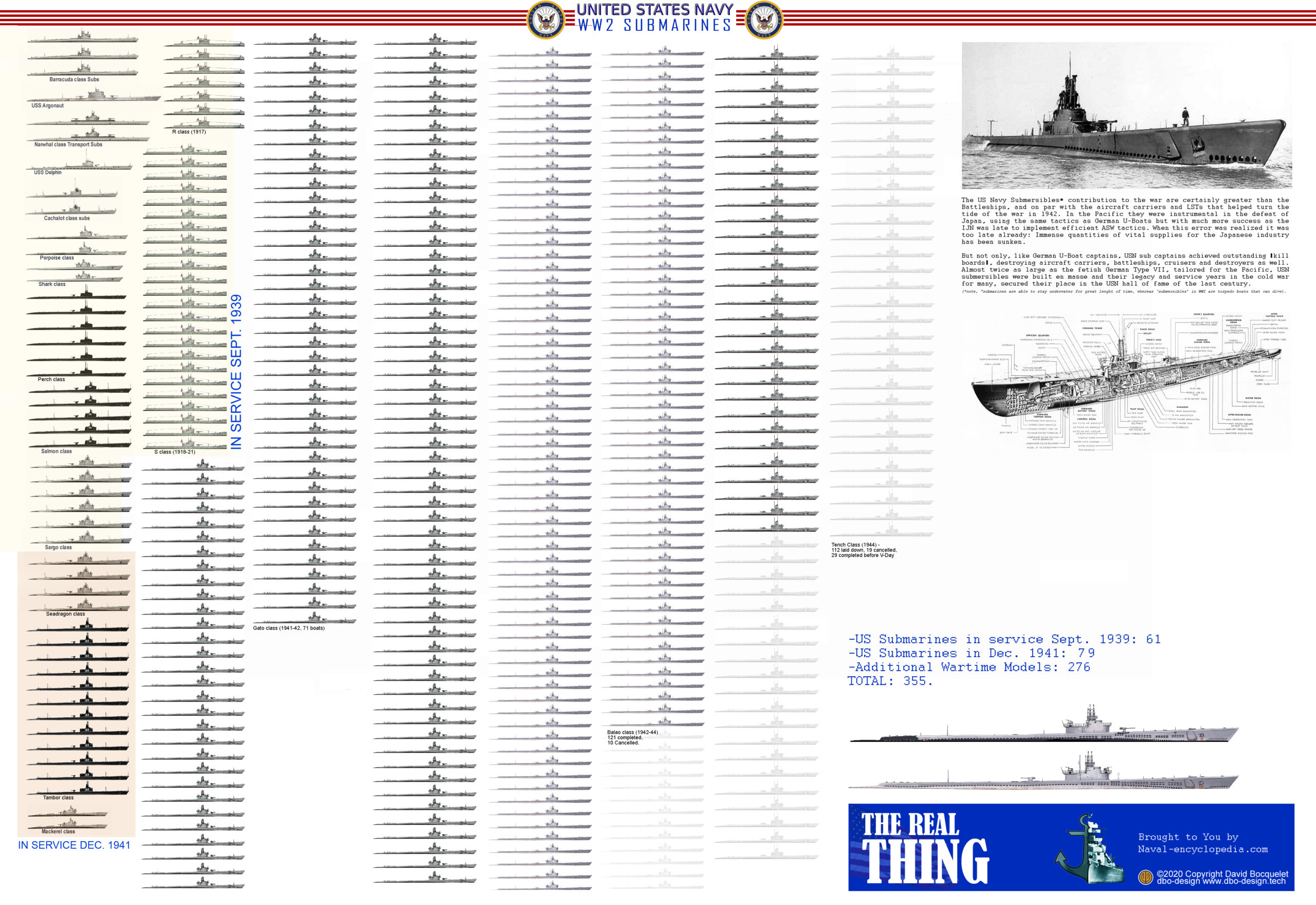
Poster (free to share and reused – CC licence) of the USN Submarines, seen in totality (the whole 355 of them).
But not only, like German U-Boat captains, USN sub captains achieved outstanding “kill boards”, destroying aircraft carriers, battleships, cruisers and destroyers as well. Almost twice as large as the fetish German Type VII, tailored for the Pacific, American submarines were built en masse and their legacy and service years in the cold war for many, secured their place in the USN hall of fame of the last century.
(*note, “submarines are able to stay underwater for great length of time, whereas ‘submersibles’ in WW2 are torpedo boats that can dive).
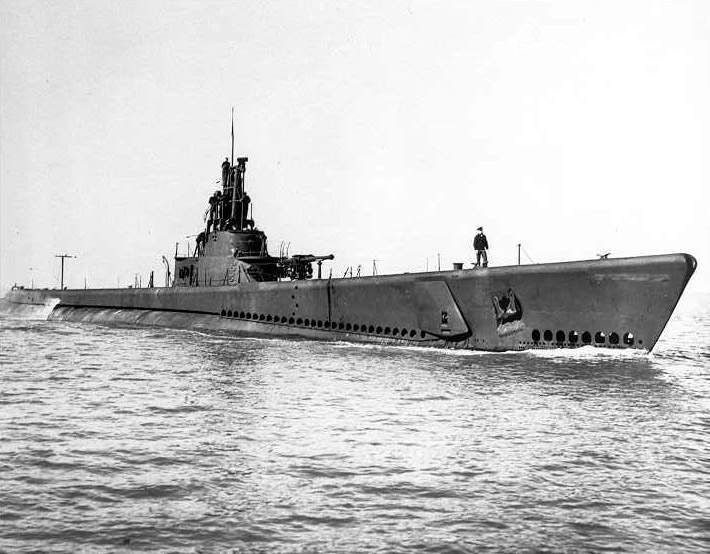
A brief on American Submarines
> See the WWI USN submarines
Before 1919 US submarine design emphasised underwater performance and quick diving; that made them generally unseaworthy on the surface. They were completely unable to cross the North Atlantic unescorted. The performance of the German U-Boats had a deep impact regarding surfaced performance, and these concepts shaped US submarine development in the interwar. The characteristics of the large US ‘fleet boats’ of World War II were strongly influenced by German design with specifics looking forward an intermediary between a proper “submarine cruiser” and a standard fleet model.
Such was the influence that the hull form of the USS Argonaut was modelled faithfully on the German late “U-Kreuzers” and the Cachalot class were largely based on the U135. US submarines were powered by diesels built under a German licence for the greatest part of the 1920s but in the 1930s a new generation of lightweight diesels were introduced, entirely of domestic origin. Emphasis was also put on electric power, and many experiments were made in direct drives, turbo-electric or hybrid, composite units. In the end, standard diesel-electric units were preferred as more reliable. Flooding of the engine compartment also became a primary concern.
The performance of the German submarines was thus a considerable shock. The German concept was to emphasise surfaced performance, regarding the submarine as a submersible torpedo-boat which might use her submersibility as a means of concealment, for example during an approach to a target. However, she would depend upon her surface performance for true mobility. These concepts shaped US submarine development in the postwar period, and are responsible for the characteristics of the large US ‘fleet boats’ of World War II. In fact the hull form of the Argonaut was based directly on German practice, and the Cachalots were based on the German U135 design of World War I. For some considerable time, too, US submarines were powered by diesels built under a German licence, although the new generation of lightweight diesels introduced in the 1930s was of entirely domestic origin.
Interwar Doctrine
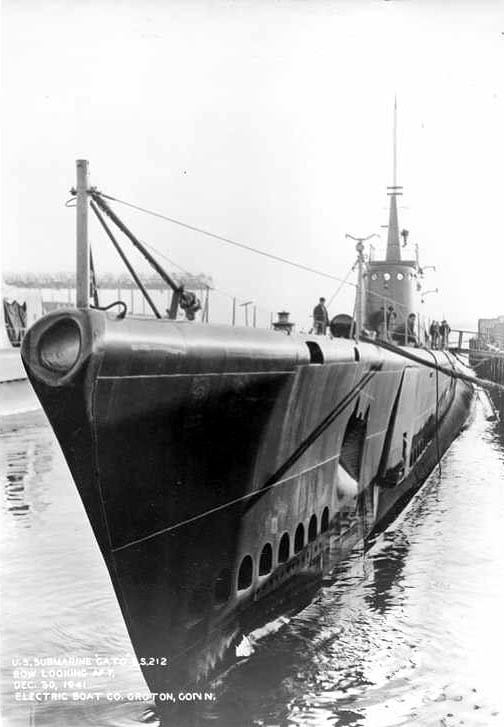
The major factor in US submarine development was the expectation of Pacific warfare: Models would be required both to interfere with Japanese operations in waters inaccessible to the US surface fleet, and to provide vital strategic intelligence – both of which functions it carried out very effectively in the war. Such operations required a long cruising radius and long endurance on station. This was militated against small submarines of other navies, and notaly Germany. So despite the fact nearly 300 submarines were built by the United States during the war, each had twice the tonnage of the average Type VIIC, so this was equivalent in reality to 600 submarines to European standards. In the wide expanses of the Pacific, the IJN also used large, if not very large “cruiser” submarines. The main difference between the two was they were NOT setup to attack merchant traffic but only and uniquely military targets.
The other major factor in US submarine development was the expectation of Pacific warfare: the submarine fleet would be required both to interfere with Japanese operations in waters inaccessible to the US surface fleet, and to provide vital strategic intelligence — both of which functions it carried out very effectively in the war. Such operations required a long cruising radius and long endurance on station, both of Which militated against small submarines of the type built by other havies during the 1930s.
U.S. Navy submarine doctrine was to support the surface fleet by conducting reconnaissance and attacking large enemy warships. Merchant ships were regarded as secondary targets, and they could only be attacked through prize rules set out in the London Naval Treaty. Crucially the USN submarine doctrine evolved in wartime, to attack merchant traffic, and “targets of opportunity” which could be military vessels when spotted. So it became the reverse as the standard peacetime doctrine, dictated by emergency. A great deal of independence was given to USN captains in operations given a certain frame and mission, whereas the Japanese tended to operated with other specialized submarines in teams and for more detailed, specific missions and purposes.
Wartime Doctrine
USN submarines has long been tailored as advanced scouts for the main fleet. But if they effectively served in that role, even sinking aircraft carriers or major ships, the bulk of their action was through unrestricted sub warfare in long range patrols. The other way to see submarines in a planned operational mode was a bit like a semi-mobile point defence. Given the fact they were slower, the admiralty tended to place them in “curtains” to ambush enemy squadrons.
This tactic resemble those of Rommel in the desert war 1941-43 when he lured allied forces with a few tanks and draw these forces on prepared positions with antitank guns. At 21 knots, USN subs in surface were perfectly able to follow a fleet, which in general had to cruise slower to be followed with tankers and supply ships. The average speed of a Japanese freighter was around 12-14 knots, not far away from the economical cruise speed of the USN submarines, at 10 knots, allowing the greatest radius of action. USN sub commander soon earned a reputation, at least internally, having an elite status, and the crews were generally better treated than their German counterparts, with roomy accomodations, air conditioning and fresh water distillation units. This all helped to develop a strong esprit de corps.
No account of the US submarine force can be complete without Mention of its misfortunes due to poorly functioning torpedoes; the torpedo problem was not really solved until 1944, atter which the Submarine force proved 50 successtul that the programme far new tonnage was cut back in 1944: boats already in operation were beginhing to run out of targets. Submarines sank the bulk of Japanese merchant tonnage destroyed by US forces in the Pacific, and thereby severely hampered Japanese operations. For example, the Japanese main fleet was based in the then Dutch East Indies in 1944 not for strategic reasons but because it was at the source of its oil; tanker traffic was too uncertain for the fleet to be able to operate from home waters.
Wartime modifications were extensive, generally involving the addition of light AA weapons, the replacement of light deck guns by heavier ones (culminating in the installation of the “wet” 5-in/25 single-purpose gun), and large increases in the number of ‘limber’ (free-flooding) holes to improve diving time; a relatively slow dive was the legacy of the US emphasis on surfaced performance. Radar, both for air search and for surface search and fire control, was installed, as well as a wide variety of sonars, including special mine-detection sets which permitted US submarines to penetrate the ASW mine barrages of the Sea of Japan and so operate in Japanese home waters. Later in the war there were also homing torpedoes for anti-escort operations, analogous to the German “Gnat”.
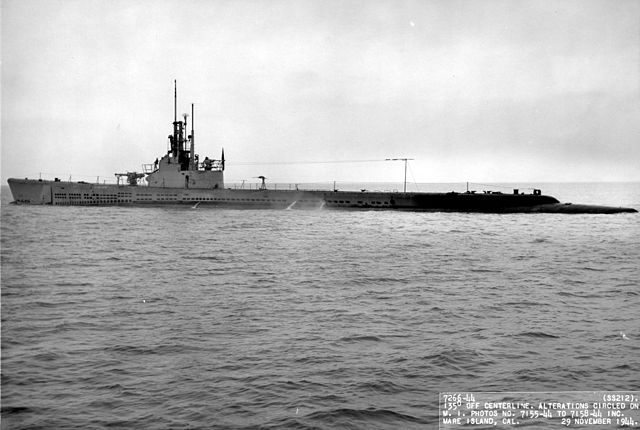
Armament
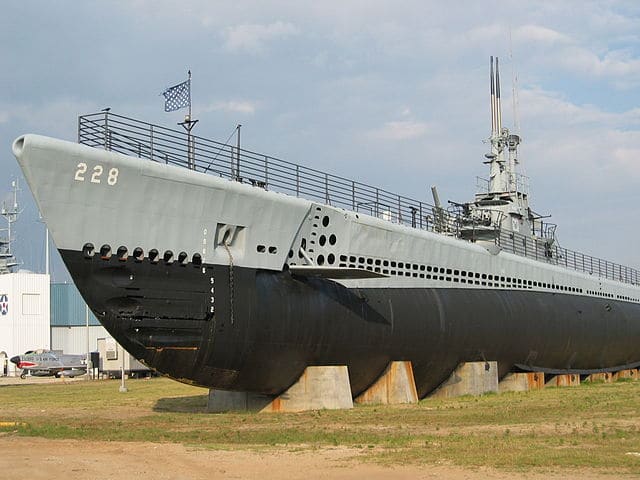
USS Drum preserved at Mobile, Alabama
Submarine torpedoes
> 21″ (53.3 cm) Mark 10
There were two types of torpedoes, the early Bliss-Leavitt 21″ (53.3 cm) Mark 9b, no longer in use (introduced 1912) and the more common submarine type 21″ (53.3 cm) Mark 10 introduced in 1917. The Mod 0 weighted 2,050 lbs. (930 kg) and the Mod 3 2,215 lbs. (1,005 kg). It was 183 in (4.953 m) long with a 400-485 lbs TNT. warhead. It was able to reach 5,000 yards (4,570 m) at 30 knots, up to 3,500 yards (3,200 m) at 36 knots for the mod 3. It was powered by a Wet-heater and guided by a Mark 13 Mod 1 gyro. Last model produced by Bliss at the Naval Torpedo Station, Newport. Used by the “S” class submarines.
> 21″ (53.3 cm) Mark 14
This infamous model was designed in 1930 and entered service in 1931. It was 20 ft 6 in (6.248 m) long, weighted 3,000 lbs. (1,361 kg), carrying a 507 lbs. (230 kg) TNT warhead, and in its basic setting could reach 4,500 yards (4,100 m) at 46 knots or 9,000 yards (8,200 m) at 31 knots but reports showed this setting was rarely used during the war.
The modification (Mark 14 Mod 3) torpedo weighted 3,061 lbs. (1,388 kg), and carried a 668 lbs. (303 kg) Torpex warhead. It was capable of reaching 9,000 yards (8,200 m) at 30.5 knots. Both models were powered by a Wet-heater steam turbine and carried a Mark 12 Mod 3 gyro. Developed as a replacement for the Mark 10, this was the standard submarine torpedo of WW2. Modified versions stayed were still used in the 1970s.
> 21″ (53.3 cm) Mark 16
Developed to replaced the Type 14 it was a high-performance but high-cost torpedo. Introduced in 1945 it had no time to see wartime service but became standard-issue up to the mid-1970s. 1,700 in total were produced.
Submersible deck guns
> 3″/50 (7.62 cm) Mark 17-18. standard deck gun first designed in 1915 and retired in 1944. The standard version was a 50 caliber. Usually Mark 17/18 with wet mountings were used on submarines, and they had the A tube, jacket and hoop of the previous versions.
> 4″/50 (10.2 cm) Marks 9: The Mark 9 was used both on destroyers and submarines, from an A tube, full length jacket, muzzle swell and using Smith-Asbury type side swing breech mechanism with a Welin block. Later monobloc construction was adopted and chromium plating used to increase life. Ud in particular on all Gato, Tench and Balao classes.
> 5″/51 (12.7 cm) Mark 9: These used a side-swing Smith-Asbury Welin breech block, a breech bush and liner locking bush (Mark 8). The Mark 9 was similar but tailored for submarines with a different screw box liner, breech and chamber. Semi-fixed ammunition were indeed provided. They were used on the Barracuda (SS-163), Bonita (SS-164) and the British “T” class submarines (SS-198).
AA Armament
-0.3 cal. MG AA. Twin or Single mounts, inside the “bathtub” of the kiosk at the rear. They were pretty useless against 500 kph planes and were removed during the war, when their kiosk was rebuilt and modernized as well.
-0.5 cal. Browning M2HB. The iconic “ma deuce” became the standard AA onboard submarines until replaced by the 20 mm Oerlikon.
-1 in (20 mm) Oerlikon gun. Installed on platforms on modernized kiosks of older submarines from 1942 onwards. Much more efficient against modern planes.
-3 in/50 gun: This dual purpose deck gun could be used with proximity fuses against aerial targets.
Wartime modifications were extensive, Generally involving the addition of 20 mm AA guns, replacing 0.3 in cal. MGs, and the replacement of light deck guns by heavier ones (culminating in the installation of the ‘wet’ 5in/25 single-purpose gun)
WW2 USN subs in action
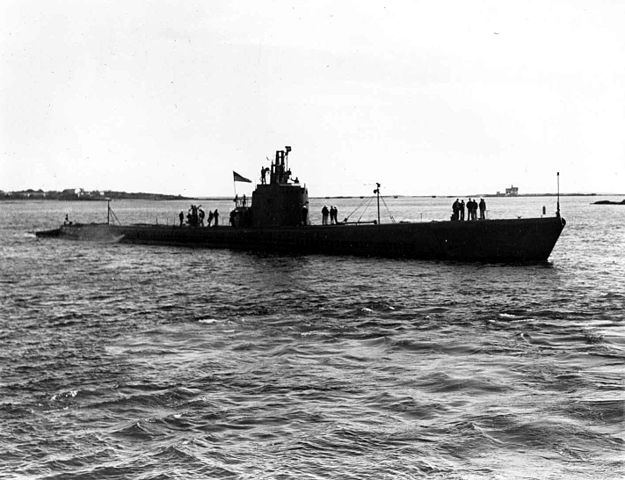
The Pacific campaign: A decisive rampage
The bulk of the USN Submarine force, fifty-one boats, were based in the Pacific, between Pearl Harbor, the west coast of the U.S., and at Manila, in the Philippines.
Despite a slow beginning after Pearl Harbor attack and the problem of defective torpedoes, the USN Submarine Force destroyed 1,314 enemy ships in the Pacific, 55% percent of all enemy ships lost and, representing a total of 5.3 million tons of shipping. 16,000 U.S. submariners participated in the pacific and Atlantic, Mediterranean campaign, loosing 375 officers and 3,131 enlisted men in 52 submarines total, the lowest casualty rate of any submarine service during the war. US Subs also conducted reconnaissance patrols, landed special forces and guerrilla troops (Notably with the refitted Nautilus and Narwhal class) in the Philippines and performed search and rescue tasks, notably stranded pilots. The other allied submarines to operate, taking the rest of the IJN tonnage lost, were British and Dutch submarines. The latter were especially successful and we will make a dedicated post on the matter. The British for example only The British had 15 modern submarines in the Far East in September 1939, 4th Flotilla, China station and later the 8th Flotilla arrived at Ceylon, but both were soon withdrawn to be sent in the Mediterranean, leaving the 15 Dutch boats based at Surabaya to operate in these waters.
Early operational (poor) results were linked to obsolete boats (the WW1 generation R and S class), classic doctrine, to misfortunes due to poorly functioning torpedoes. These problems took time to be assessed by the ordnance and not really solved until 1943. It was to wai for the submarine force proved so successful that the programme for new surface ships was curtailed in 1944 as well as submarines: Indeed, the ones already in operation were starting to simply run out of targets. They succeeded where the Kriegsmarine failed for the Atlantic, despite the lower numbers of submarines and much larger area of operations: Japanese shipping routes spanned the Pacific from the Gilbert Islands to the Malay Peninsula, from the Kuriles to the Dutch East Indies. That was far more surface area to cover than the Atlantic north and south.
Before the war submarines were attached to the three U.S. Fleets, Atlantic, Pacific and Asiatic Fleets. Soon the Pacific fleet represented the bulk of the action, extended during wartime while the Asiatic force was renamed Commander Submarines, Southwest Pacific (ComSubSoWesPac) and later 7th Fleet. It was divided between the ComSubPac (or ComSubForPac) and ComSubSoWesPac along the 20° north parallel from the coast of China to a line just a few miles east of the Philippine Archipelago, then directly south to the equator, and then eastward along the equator.
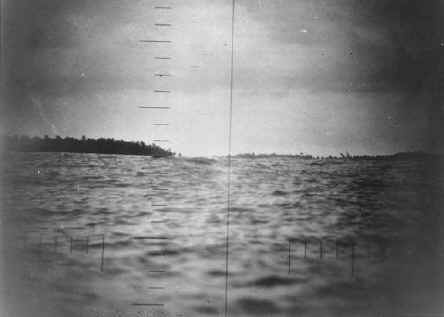
Makin raid: As seen by USS Nautilus’s periscope. ‘Spec-ops’ operations often required modified submarines, just like the British in the Mediterranean or Norway.
From 1942, older generation (interwar) models were modified. The huge USS Argonaut, Nautilus and Narwhal for example, for special operations, with holds to carry personal. But also all classes undergone refits: They were large increases in the number of ‘limber’ (free-flooding) holes to improve diving time for example. A relatively slow dive was the legacy of the US emphasis on surfaced performance. Radar were installed, both for air search and for surface search and fire control, and a wide variety of sonars, notably a special mine-detection set. This crucially, permitted US submarines to penetrate IJN ASW mine barrages of the Sea of Japan and to rampage in Japanese home waters as well. Kiosks were also rebuilt, smaller and lighter, with open-deck and platforms for a better AA. Also submarines started to operate homing torpedoes for anti-escort operations, analogous to the German “Gnat”.
USN ww2 submarines sank the bulk of Japanese merchant tonnage in 1942-45, they were more successful than planes in this regard, severely hampering Japanese operations and largely contributing the victory in the Pacific. The Japanese main fleet of the Dutch East Indies in 1944 was unable to operate for example mainly because the IJA was deprived of oil. Tankers became absent of these waters. It’s not they all had been sunk, but they just refused to operate in these waters. This went so badly that the Japanese developed in 1944-45 series of small supply submarines, hoping they would escape the vigilance of USN submariners.
By extension on land, planes could not fly, trucks and tanks could not start. On many isolated islands of the pacific, supplies failed to reach garrisons left to eat what they would cultivate or forage in the area. More important islands were deprived of munitions as well and worst of all, the loss of thousands of troop reinforcements. All this accelerated the fall of the IJA, and of the Japanese industrial capabilities as well. Indeed, the Japanese home islands was soon deprived of critical war materials. Importations fell from 20 millions tons in 1941 to 10 millions in 1944. This, combined with a more intensive bombardment campaign from mid-1944 gradually starved and destroyed any means of production, even more badly than in Germany, where it was reorganized, hidden and modularized by Albert Speer.
The paradox is that the allied submarine campaign is one of the least-publicized feats in military history, first off because it was kept secret from the medias, and even from the Congress in the US, as the admiralty applied an unrestricted submarine warfare without formal consent. Indeed, the US was tied to the London Naval Treaty, which required submarines to abide by prize rules (“cruiser rules”), and must be therefore armed auxiliaries.
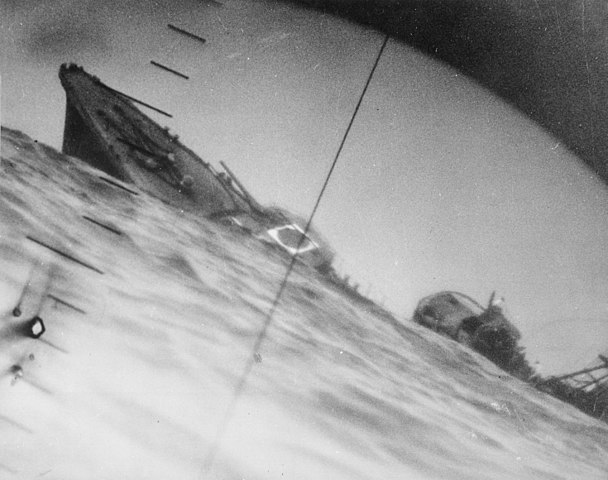
IJN Shimakaze torpedoed and sinking, as seen from a USN sub’ periscope.
The torpedo scandal
USN Submarines alternated between deck guns and torpedoes depending on the situation. Due to the nature of silent penetration in the enemy controlled areas, torpedoes were of course more common and the 5-in gun was estimated the only one viable for easy surface preys. If one or two 3 or 5-inch plus 50-caliber machine guns were carried, the typical torpedo load was ten ready 21-inch torpedo tubes and 18 spare torpedoes, so 28 total. Each one was capable to sink a ship on its own, in theory.
TNT was the staple of warheads early in the war, but it shifted to the more powerful Torpex. However, the explosion force was not the main issue with early operations: The main service torpedo was called the Mark 14. Rushed into production with incomplete testings, it proved a ordnance major fail during this war. Frustrated Captains reported “duds” (torpedoes failing to explose after contact, as the Mark 6 exploder proved unreliable) but also runs below the enemy hull as the type did not remained at the proper depth setting after launch. But what topped everything up was the circular run. Among submarines in wartime sank in foggy conditions (it was assumed generally by IJN depht charges), there are strong suspicion that at least in several occasions, it was a self-inflicted torpedoing. At least one report of a sub that barely escaped that event and was still around to tell about it forced to reconsider the guidance.
For the exploder, the ordnance engineers thought at first it as the fault of the magnetic influence fuzing. In June 1943, Admiral Nimitz ordered their retirement and replacement by older, trusted models. He ordered an enquiry from the materiel establishment to discover the reasons for malfunctions, but it proved very difficult to convince the Bureau of Ordnance that the failures were not caused by personnel management. VADM Lockwood fire tested torpedoes against seaside cliffs at Kohoolawe in Hawaii and eventually proved the charges were grounded, showing that the firing pin design was defective. Until these issues were fixed in 1943, Sub captains took extraordinary risks for often little results. The Bureau of Ordnance finally aknowledged a major redesign of the troublesome Mark 14 torpedo was necessary.
USN Submarine aces
Althought as it was said above, the “silent service” was also silent in the medias, submariners and their officers did not shy of actions and rampaged though Indonesia, the Philippines, the Gilbert, Marshall, Caroline and Mariana Islands, New Guinea, the Dutch East Indies, and the western Aleutians, some reaching elite status, ad becoming “aces” of their own, in fact the most prominent allied submarines aces of the war.

Despite the lack of publicity, statistics were gathered by the Joint Army-Navy Assessment Committee (JANAC) while surviving WWII submariners have recognized a few top skippers and their submarines. Now this heritage is better known and recalled in the preserved USN submarines used as museums today.
The subject is the matter for a fully-fledged article, so it can be at least discovered in this excellent article from usn-history.
The forgotten USN subs of the Atlantic
It was clear that early on the Pacific was designed as the main theater of operations for submarines. First off because the number of serviceable American submarines was limited. The Chief of Naval Operations left a directive on 7 December 1941 to “Execute unrestricted (air and) submarine warfare against Japan”. Main mission was anti-ship, especially prized targets such as Japanese capital ships and later in the war, priority was placed on merchant ships to hamper critic Japanese supplies war materials in general, fuel, and food.
On 13 April 1944, the new submarines targets were fleet destroyers, in order to reduce the defensive strength of combatant groups, but secondary always to merchant shipping, and into that, the utmost priority was given on tankers. Current doctrine for the Pacific
On other fronts it was not as clear, but the Atlantic had priority over the Mediterranean (from November 1942).
There is an interesting aspect of the battle of (Western) Atlantic, operations conducted in and around the Caribbean Sea, where U-boats were present in 1942. There is a thesis on the matter, “American Antisubmarine Operations in the Atlantic, May 1943-May 1945,” by Dr. Philip K. Lundeberg.
American submarines played only really a minor role in the defeat of Germany and the whole force never exceeded the six boats of a single unit operating called Submarine Squadron 50 it spent only eight months on station, patrolling off Western and Northern Europe but their results there were meager. Indeed, axis surface ships were rare in these waters, while catching U-Boats was difficult.
“Subron 50” was not subjected to some “grand strategy” but it came from a personal request by Winston Churchill during the Second Washington Conference in June 1942. He reasoned that these submarines having superior endurance and firepower coulg bring some help in the North Atlantic, taking the role of smaller British subs operating on the North Sea and Mediterranean.
The commander in chief, Admiral Ernest J. King, at first disagreed and argued none could be diverted to the Pacific. But President Roosevelt prevailed and on September 3, 1942, Submarine Squadron 50 was based at New London, Connecticut, and six Gato-class boats were gathered by Captain Norman S. Ives. The first made their trip to UK in the end of October (19), USS Blackfish, Gunnel, and Shad, followed by Herring and Barb (20) and USS Gurnard two weeks later. Their definitive operating base was U.S. Naval Base II, in Rosneath, Scotland, 24 miles northwest of Glasgow.
However their first important mission was in the Mediterranean deployed for the first large-scale allied amphibious landings, Operation Torch, in French North Africa. USS Barb was assigned the task to drop GIs off in Morocco, south of Casablanca. USS Gunnel was also operating there, but near-missed by an allied air attack. Meawnhile, USS Blackfish was interdicting Vichy French reinforcements from Dakar. On November 8, USS Herring mde the first “kill” of this force, sinking the Vichy-French liner Ville du Havre. Next, the squadon was back in Scotland and deployment consisted in hunting blockade runners transporting goods from neutral Spain to Vichy France in the Bay of Biscay.
Read More/Src
//wiki/Category:World_War_II_submarines_of_the_United_States
//en.wikipedia.org/wiki/Allied_submarines_in_the_Pacific_War
//www.navweaps.com/Weapons/WTUS_WWII.php
//nationalinterest.org/blog/buzz/they-sunk-empire-how-us-submarines-crushed-imperial-japan-during-world-war-ii-50167
//www.public.navy.mil/subfor/underseawarfaremagazine/Issues/Archives/issue_06/silent_victory.html
//www.sftourismtips.com/image-files/xuss-pampanito-in-sf.jpg.pagespeed.ic.E_SXS2_uWt.jpg
//www.navyhistory.org.au/royal-navy-colours-of-world-war-two-the-pattern-507s-g10-and/
//fr.naval-encyclopedia.com/2e-guerre-mondiale/us-navy-2egm.php#sub
//maritime.org/doc/subsinpacific.htm
//en.wikipedia.org/wiki/List_of_submarine_museums
//usnhistory.navylive.dodlive.mil/2017/03/28/leaders-of-the-deep-top-wwii-submariners-and-their-submarines/
//fleetsubmarine.com/
//americanhistory.si.edu/subs/history/subsbeforenuc/ww2/
//acepilots.com/ships/auxiliaries.html
Visual References (Pinterest)
Visual references:
//i.pinimg.com/originals/dc/e5/a2/dce5a2dc1f18447ad11af2411ed3e1f4.jpg
//www.the-blueprints.com/blueprints/ships/submarines-us/
Modellers corner

Blueprints on the floatingdrydock.com
-USS GATO SS-212 (1944) Fleet Sub 1/200 Riich
-USN Guppy II Class Submarine 1/350 AFV Club
-GATO Class Submarine 1/350 AFV Club
-USS Gato Class Submarine 1941 1/350 AFV Club
-Revell Gato-class submarines 1/72 -Review
-Tamiya 1/700 WL series package CV Taiho & USN Gato/IJN Sub Chaser No. 13
-Aoshima 1/700 WL series USS Gato
-Doyusha 1/700 SS212 1944
-AFV Club 1/350 Gato class 1941
-HobbyBoss 1/700 USS Balao
-HobbyBoss 1/700 USS Gato

Books:
-US Submarines 1941 45 by Christley, Jim (Osprey Publishing, 2006)
-Sqn Signal 28 Gato class subs in action
-U.s. Submarines Since 1945: An Illustrated Design History by Norman Friedman
Videos
https://www.youtube.com/watch?v=6HlJOY-ewhk
Documentary (Unknown origin)
//www.youtube.com/watch?v=7mxzKuzN4wc
//www.youtube.com/watch?v=BcGD1acLY50
//www.youtube.com/watch?v=bgAHNa390-Y
//www.youtube.com/watch?v=3pcyhqXvRQ0
3D Corner
//3dwarehouse.sketchup.com/model/3aca41d08c5fc4ee9ef4f033b7e0887/Gato-Class-Submarine?hl=en
//www.cgtrader.com/3d-models/watercraft/military/gato-class-submarine-ss-229-uss-flying-fish
//sketchfab.com/3d-models/tench-class-submarine-8e411ea909cc47f0b9720cc3fc0a0ef0
Nomenclature of American submarines of WW2
 R class subs (1918-19)
R class subs (1918-19)
Class: 27 boats total, 19 in service 1941

The SS13 in 1941 (1/400).
These old boats had for them an advanced design in 1918, rock solidity and good diving performance, compared to other models, as well as scrupulous maintenance. So it is no coincidence that 19 of them, out of a total production of 27, were still in service in the United States Navy, mainly paid to the reserve or used as school boats. Some were transferred to Great Britain. Only one was lost by acts of war, while returning to the British in June 1942 following a collision. The others ended the war peacefully and were scrapped in 1946.
Characteristics (1941)
Displacement: 570 t surface, 680 t submerged
Dimensions: 56,74 x 5,5 x 4,42 m
Propulsion: 2 shaft, diesels, 2 Westinghouse eletcric motors 4,000 hp 13,5/10,5 knots surf/subm.
Armament: 4 x 533 mm bow TTs, 1 deck 3-in gun (76 mm).
Crew: 30
 S class subs (1920-23)
S class subs (1920-23)
Class: 51 boats

SS39 in 1941
The production of submarines was almost constant in the USA between the two wars. Last series designed at the end of the great war, and drawing lessons from the conflict, the S class sometimes also called “Sugar” class included 51 units, built and launched at Bethlehem Steel and Union Iron Works (Electric boat Cie, type Holland) for the first group, Portsmouth Navy yard and Lake for the second, Fore River for the third and Lake again for the fourth, the last being launched in 1925 and accepted in service the following year. Based therefore on the average ocean design of O and R, they did not have the range to intervene effectively in the Pacific.
The majority therefore served in the Atlantic, and they formed the spearhead of the fleet of American submarines from the interwar period. Three were lost at sea, then three other scrap. From the forties they passed to schooling, the provisioning, the patrols and the coastal defense, then in 1943, all were versed in the training of the young recruits. Six in this role were transferred to the Royal Navy. 5 were lost of which only one, the S44 by acts of war in October 1943. Their specifications varied greatly from one series to another.
Characteristics (1941)
Displacement: 906 t surface, 1230 t submerged
Dimensions: 65-73 x 6,3-6.6 x 4,1-4.9 m
Propulsion: 2 shaft diesels, 2 Westinghouse eletcric motors 1,000/600 hp 15/11 knots surf/subm.
Armament: 4-5 x 533 mm bow TTs, 1 deck 4-in gun (102 mm).
Crew: 43
 Barracuda class subs (1924)
Barracuda class subs (1924)
Class: USS Barracdua – V1-V3

USS Barracuda in 1943
From the T series dating back to 1919, the Barracuda learned lessons from the war and from the study of U-boats awarded for repair. Post-Washington type, they were designed for a long cruise and were part of no less than 8 quite different prototypes. They also took advantage of MAN diesels, built under license, and Westinghouse electric motors of a new model, giving them a total of 80 days of mission time at sea. The USS Barracuda was therefore the first of these eight prototypes (V1), followed by the USS Bass (V2) and the USS Bonita (V3).
Their powerful diesels gave them a speed (on paper) of 18.5 knots, normally sufficient to follow the squadrons. They therefore constituted a fundamental break with the “Holland” models built so far, excellent in diving but slow on the surface and of low autonomy. Their range was 6,000 nautical miles and their practical depth was 122 meters. In 1934, their age and semi-experimental nature relegated them to the reserve, and they were used from 1941 as training units.
Characteristics (1941)
Displacement: 2119 t surface, 2500 t submerged
Dimensions: 109.96 x 8.4 x 4,6 m
Propulsion: 2 shaft MAN/Sulzer diesels, 2 Westinghouse electric motors 6,200 hp 18.7/9 knots surf/subm.
Armament: 4 x 533 mm bow, 2 Stern TTs, 1 deck 5-in gun (127 mm).
Crew: 85
 Narwhal class subs (1927)
Narwhal class subs (1927)
Class: USS Narwhal, Nautilus

USS Narwhal in 1939
The V5-V6 series (Narwhal and Nautilus) were two prototypes of the 1916 program derived from the study of the U135. Like the Argonaut, they bet on the concept of ocean cruisers, with in particular a very great autonomy. Shorter than USS Argonaut, they were nonetheless deeper (5.88 instead of 5.16 m) and therefore had a tonnage of nearly 4000 tonnes when diving. They were therefore for almost 40 years the largest submarines in service in the US Navy. It was the USS Nautilus of 1957, the first SNA, which exceeded in tonnage its ancestor of the same name.
Their MAN diesels under license practiced big problems of vivrations and sound insulation and were therefore replaced in 1941 by Morse- Fairbanks, and their electric motors by those of the Gato series. In 1942-43 they mainly served to supply isolated garrisons in areas controlled by the Japanese navy. Their kiosk was rebuilt and rearmed to 1943 submersible standards. They then went to training and were struck off the lists in 1945.
Characteristics (1941)
Displacement: 2987 t surface, 3960 t submerged
Dimensions: 113 x 10.15 x 5,88 m
Propulsion: 2 shaft MAN/Sulzer diesels, 2 Westinghouse electric motors 5,630/1300 hp 17.4/8 knots surf/subm.
Armament: 4 x 533 mm bow, 2 Stern TTs, 2 deck 5-in gun (127 mm), 2x 20 mm Oerlikon AA.
Crew: 89
 USS Argonaut (1927)
USS Argonaut (1927)

USS Argonaut in 1939 (scale 1/400)
The USS Argonaut was a unique case in the US Navy. Designed from a German design of “ocean submersible cruiser”, it was at the forefront of a long series of experiments and limited series that would forge the new generation of American submarines, especially that of the many ” fleet subs “of the war. In the early twenties this concept of “big cruise” was in fashion. The British launched the X1 class, the French Surcouf, and the Italians the Ballila class. USS Argonaut was the result of three other prototypes and first to bore the name V4 before being accepted into service. This exceptional submersible, the largest ever built in the USA before the nuclear age, had a range of 16,000 nautical miles.
However from the drawing board, her large cruiser guns and low speed contained some contradictions which made her less suited for her interned role and she was modified on plans for minelaying. In this role, she was equipped to carry 60 mines. She was finally launched in Portsmouth in 1927 and completed, accepted in service in 1928. In wartime, the usefulness of a minelayer soon gave way to a more urgent role, that of supplying the Marines, especially those stranded at Guadalcanal. Renamed APS2, she received an enlarged room for troops and supplies and operated at Makin Island in August 1942. She was sunk by the Japanese navy in January 1943.
Characteristics (1941)
Displacement: 2987 t surface, 3960 t submerged
Dimensions: 113 x 10.15 x 5,88 m
Propulsion: 2 shaft MAN/Sulzer diesels, 2 Westinghouse electric motors 5,630/1300 hp 17.4/8 knots surf/subm.
Armament: 4 x 533 mm bow, 2 Stern TTs, 2 deck 5-in gun (127 mm), 2x 20 mm Oerlikon AA.
Crew: 89
 USS Dolphin (1931)
USS Dolphin (1931)

USS Dolphin in 1939
This unit, launched in March 1932, tried to answer to the problem of meeting an acceptable compromise for an oceanic long-range submersible, with a production perspective. She was a late prototype, part of the “V” program initiated in 1916. An ideal compromise was reached by sacrificing speed, at least on paper. Indeed, USS Dolphin was disappointing in testing, and later in operations. She was used for training during the war, discarded after V-day in September 1945 and scrapped in 1947.
Caracteristics (1941)
Displacement: 1688 t surface, 2215 t submerged
Dimensions: 97.31 x 8.5 x 4 m
Propulsion: 2 shaft MAN/Sulzer diesels, 2 Westinghouse electric motors 3500/1750 hp 17/8 knots surf/sub.
Armament: 4 x 533 mm bow, 2 Stern TTs, 1 deck 4-in gun (102 mm), 4x 8 mm MGs.
Crew: 66
Cachalot class submarines (1933)

USS Cuttlefish in 1937
The experimental series of Vs initiated in 1916 will see its logical conclusion with the “Cachalot”, a limited series of 2 units starting with the top seed, the V8 (SC4) then USS Cachalot (SS-170). Built in Portsmouth Naval Yard, Kittery, it was based on the USS Dolphin while trying to improve a certain number of points, but especially on the design of the U135 of which it was an “Americanized” version… Launched in October then accepted in service in December 1933, its hull was reinforced to dive more than 190 meters, while its speed was further reduced to make more room for fuel oil, hence a comfortable radius of action of 16,000 nautical miles and a carry of 16 torpedoes, which extended their operational capabilities.
They used a full double hull, and were smaller than the previous generation, with new, powerful MAN diesels giving them a speed of 17 knots. He was followed by his sister-ship V9 (USS Cuttlefish). The latter differed in many respects. It was entrusted to Electric boat, a private contractor, a first since the early 1920s, was a little more spacious, used air conditioning, and its hull was partially welded. In use, their diesels gave so much vibration that they were replaced by General Motors. They also tested the first torpedo calculation computer. In the end, their too cramped design condemned them to short patrols. They made three trips to the central Pacific during the war, without success, then went to training in New England and were retired from service in 1945.
Characteristics (1941)
Displacement: 1120 t surface, 1650 t submerged
Dimensions: 83 x 7.5 x 4.27 m
Propulsion: 2 shaft MAN/Sulzer diesels, 2 Westinghouse electric motors 2750/1500 hp 17/8 knots surf/sub.
Armament: 4 x 533 mm bow, 2 Stern TTs, 1 deck 3-in gun (76 mm), 2x cal.03 mm MGs+ 3x cal.05.
Crew: 51
 Porpoise class submarines (1934)
Porpoise class submarines (1934)
Class: USS Porpoise, Pike, Shark, Tarpon, Perch, Pickerel, Permit, Plunger, Pollack, Pompano

USS Porpoise en 1944

USS Shark en 1942

USS Perch en 1939
The boats of the Porpoise class (or “P” class) were an evolution of the prototype USS Cachalot, but taking in account all the limitations of the previous boats, notably those discovered during sea trials. The Porpoise class was at the origin of three pre-series built between 1934 and 1937 : The Porpoise (P1) group also comprised the USS Pike, while USS Shark (P2) comprised the USS Shark USS Tarpon, and the Perch class (P3), comprises the USS Pickerel, Permit, Plunger, Pollack et Pompano. They are generally considered as the beginning of the lineage that would lead directly to the famous wartime “Gato” class.
Dimensions were quite superior to the previous boats, with about 91 meters long. The underwater tonnage was about 1934 to 1998 tonnes. To reduce vibrations it was attempted a new arrangement by diesel engines coupled with electric generators. All electric propulsion did not gave satisfaction in the admiralty, Intermediary power lost amounting to 360 hp. The Winton 16-201 diesels proved troublesome and the boats were later (1942) refitted with new 12-278A models, reliable and more powerful. As the same time, all units were re-equipped with more conventional arrangements. Operational radius was about 12,000 nautical miles and they carried 16 torpedoes, so they were ideally suited for an extended service in the Pacific.
Their diving time was also improved thanks to new apertures and ballasts arrangements, and their construction called for welding all-around, a first at that time. This gave the benefit of both lightness and better resistance to vibrations and leaks when depth-charged. Max test depht was about 250 meters (820 feets), a real improvement compared to the previous classes. These units were also modernized in 1942, fitted with a sonar and radar, and brand new command center in the kiosk. The latter was also rebuilt completely in 1943 notably to place two aft staged platforms for oerlikon 20 mm guns while receiving a new surface radar. These boats were considered recent enough to be frontline in the pacific until 1944. They were then moved to home waters to be used as school subs until the end of the war and discarded soon after. They were broken up in 1946. The long “fleet boats” line they would inaugurate will go up to the “Tang” of 1951.
Characteristics (1941)
Displacement: 1350 t surface, 1990 t submerged
Dimensions: 91.6 x 7.9 x 4.6 m
Propulsion: 2 shaft Winton diesels, 4 GE electric motors 2600/4000 hp 19/8,7 knots surf/sub.
Armament: 4 x 533 mm bow, 2 Stern TTs, 1 deck 4-in gun (102 mm), 4x 7.7 mm MGs (1942 2x 20 mm AA)
Crew: 50
 Salmon class submarines (1937)
Salmon class submarines (1937)
Class: USS Salmon, Seal, Skipjack, Snapper, Stingray, Sturgeon

USS Salmon en 1938
The successful experience with the three “P” subclasses (Porpoise, Shark, Perch), was rebooted by the admiralty to test three alternative builders for the FY 1936 serie: Electric boat, Groton (Salmon, Seal, Skipjack), Portsmouth Naval Shipyard (Snapper, Stingray) and Mare island naval shipyard, Vallejo (California) for the USS Sturgeon. All that worked well with the previous boats was repeated in the design but the kiosk was modified and made roomier, the hull was reinforced and enlarged, a more powerful engine was fitted, making the speed rise in surface.
The hull was also fitted with two more stern torpedo tubes (so for in all, like the bow, eight total). Four additional torpedoes were stored vertically in “wells” around the kiosk, and they required a long and careful procedure on the surface to reload the tubes. The problem was the same on the spacious Type IX U-Boats. The USN admiralty later estimated it was a too risky business, especially in close proximity with enemy bases. The subs built by electric boat tried a new double-action HOR (Hooven-Ovens-Rentschler) engines but they showed excessive vibration in use, and were replaced ultimately by more reliable Winton 12 cylinder units.
The hull was of the “double partial hull”, with a part of the ballasts used as oil reserves. This system presented the advantage of allowing reparations of the external hull even submerged from the inside, as they could be partially filled with air, just enough to allow human intervention without a breathing apparatus, the crew proceeding inside via a sas.
The Salmon class boats entered service in 1937-1938 and were immediately sent in the Atlantic coast, notably for the defence of the panama canal zone. Once their station was over, they joined the Pacific, their first intended area of operations. They will demonstrate their excellent overall design, defending the Philippine with Sargo class boats, under orders of the admiral C. Hart. It appeared however that their large kiosk was too conspicuous and they were the first to receive a new standard kiosk, smaller, fitted with standard aft platforms for AA guns, which apparently were about to be generalized, as well as a surface radar. Their initial 4-in gun was judged too weak and replaced by a 127 mm gun in 1943. None of these submarine was lost, amazingly given what they went through, and they served on the front line until 1945, being retired afterwards.
Characteristics (Salmon, 1941)
Displacement: 1458 t surface, 2233 t submerged
Dimensions: 94 x 7.96 x 4.78 m
Propulsion: 2 shaft HOR/Winton diesels, 4 GE electric motors 5500/2600 hp 21/9 knots surf/sub.
Armament: 4 x 533 mm bow, 2 Stern TTs, 1 deck 4-in gun (102 mm) (1943: 5-in), 4x 7.7 mm MGs (1942 2x 20 mm AA)
Crew: 59
 Sargo class submarines (1938)
Sargo class submarines (1938)
Class: Sargo, Saury, Spearfish, Sculpin, Squalus, swordfish, Seadragon*, Sealion*, Searaven*, Seawolf*

USS Sargo en 1938
Reaearches showed a single leak and flooding of the diesels could aso disabling the all-electric system therefore a direct-drive via hydraulic couplings was designed. The all-electric design of the Porpoise was not realized yet when the Sargo-class powerplant was designed. The Sargo were fitted with diesel-electric reduction gear drive and no composite system was ever used again. The reversion made for a shorter hull, doubling the battery capacity, ad fitting longer torpedo tubes. Therefore two more tubes were fitted in the stern. 24 torpedoes were carried in all, 12 in the forward torpedo room, 8 i the aft torpedo room and an extra 4 stored in external wells. 32 mines tailored for the torpedo tubes could also be carried.
In all they could reach 11,000 nautical miles at 10 knots, 30% kept diverted for battery charging. These subs were able to sustain 8-3/4 knots for one hour while submerged and sustain a 2 knots speed for 48 hours. There was indeed enough room inside to store breathable air plus air conditioning and an auxilia machinery for independent electric power. So these boats could sit on the bottom around 200 m deep and wait for tow days, largely enough for any IJN destroyer or sub-chaser to leave the area.
There was a later sub-class launhed in 1939, called “Seadragon” (SS194). Like the next three boats, these developed 5200 shp thanks to a diesel electric units. USS Squalus sank and helped identified, after being raised, a major defect with the main induction hatch. After being raised, she was renamed USS salfish. Sculpin, Sealion and Seawolf were sunk in action during the war. ike the other prewar boats they were modified in 1942-43, with a brand new kiosk, equipments, and AA guns.
Characteristics (Sargo, 1941)
Displacement: 1450 t surface, 2230 t submerged
Dimensions: 92.20 x 8.18 x 5.08 m
Propulsion: 2 shaft diesels, 4 GE electric motors 5500/2740 hp 20/8.75 knots surf/sub.
Armament: 8 x 533 mm TTs (4 bow 4 stern), 1 deck 3-in/50 gun (76 mm) (1943: 5-in), 2x 0.3, 2x 0.5 cal. MGs
Crew: 59
 Tambor class submarines (1938)
Tambor class submarines (1938)
Class: USS Tambor, Tautog, Tresher, triton, Trout, Tuna, Gar, Grampus, Grayback, Grayling, Grenadier, Grudgeon

USS Tautog en 1940
This last pre-war class really became the mold into which the Gato class was shaped and mass-produced during the war. These units were not revolutionary in any way, they just proceeded from the same previous design of the Sargo class, with an almost unchanged hull, slightly shorter, with less draft, but widened, and a return to diesel-electric. They followed-up the adoption of a supplementary pair of bow torpedo tubes. While their blueprints were not even started and first sketches drawn, they were thought in the context of a rapidly degrading relations with Japan and it was established they would be featured in a scenario of commerce raiding against Japanese trade lines; Therefore their hull was strengthened and their displacement rose accordingly. Speed remained unchanged despite of this, the slight loss compensated by the adoption of a more powerful power unit.
The Tambor class boats carried all their 24 torpedoes internally, 16 forward and 8 aft. They could also carry 40 mines. They were found capable of operating at depths beyond 130 meters (426 feets) and their estimated crushing depht was estimated to be well beyond 250 meters (820 feets) in fact. The class comprised 12 boats launched between december 1939 and january 1941, including 7 which were sunk in operations. The five survivors were disarmed in 1948, 1959 et 1960.
Characteristics (Sargo, 1941)
Displacement: 1475 t surface, 2300 t submerged
Dimensions: 92.2 x 8.3 x 4.57 m
Propulsion: 2 shaft diesel-electric 5400/2740 hp 20/8.75 knots surf/sub.
Armament: 6 x 533 mm bow, 4 Stern TTs, 1 deck 3-in/50 gun (76 mm) (1943: 5-in), 2x 0.3 cal. MGs (1942 2x 20 mm AA)
Crew: 60
 Mackerel & Marlin class submarines (1940)
Mackerel & Marlin class submarines (1940)
Class: USS Mackerel, Marlin

USS Marlin en 1941
These two singular boats, USS Mackerel and Marlin, were attempts to design light submarines, on the initiative of the expert of the submarines direction, admiral Hart. He envisaged the replacement of the oldest subs of the “S” class in order to better coastal defense, for which large oceanic vessels seemed too costly and ill-suited. These studies led to the launch of two experimental units, the USS Marckerel and Marlin were built, under FY39 procurement. They displaced 800 tonnes, and differed in their propulsion. They had a rather short radius of action but were well adapted to their function. USS Mackerel differed in size: 72.82 m long, 6.60 wide, 3.96 m draft, displacing 800/910 tons standard in surface and 1165 tons submerged. Her two shaft diesels developed 1700 shp (20 shop difference) and she was 0.3 knots faster. Armament remained the same for both.
However submariners did not liked them, finding them quite cramped. The concept was not followed as the war broke, and they played a minor role during the conflict, carrying out patrols near the coast before being disarmed in 1946-47. Before the war, the admiralty expressed the need for such submarines to defend the waters aroud the Paname canal, Hawaii, and the US Coast, but it never materialized as wartime emergency imposed a single mass-built fleet boat. The Gato class was next indeed.
Characteristics (Mackerel, 1941)
Displacement: 825/940 t standard surface, 1190 t submerged
Dimensions: 74 x 6.73 x 4.27 m
Propulsion: 2 shaft diesels-electric 1680/? hp 16 knots surface
Armament: 6 x 533 mm TTs (4 bow, 2 Stern), 1 deck 3-in/50 gun (76 mm), 2x 0.3, 2x 0.5 in MG.
Crew: 42
 Gato/Balao/Tench class submarines (1940)
Gato/Balao/Tench class submarines (1940)
Class: SS212-529 (29 cancelled 29.7.1944)

USS Balao (top) and Tench (bottom) general appearance – 1/400 author’s illustration
These slightly improved models of the FY41 and war programmes became the famous mass-produced US ‘fleet boats.’ The basic design was lengthened slightly for improved stability, more subdivisions in the engine rooms into two compartments, and a pressure-proof watertight bulkhead was introduced as a separation. The auxiliary ballast tanks were enlarged, to compensate for the variation in weights when carrying and spending 24 torpedoes or 40 mines. The longer hull also had the advantage of allowing the installation of 2000 bhp diesels, at least on paper, as they were planned for FY42 but never installed. More powerful generators were really fitted insted as a 1943 upgrade. A few boats tried electric motors coupled directly to the propeller shafts also.
Gato-class and very close Balao and Tench boats were designed to dive an cruisrer underwater at 300ft; but with simplifications in design and construction, more weight was saved, allwig a thicker hull, and this from SS285 onwards went down to 400 ft. In 1945, the SS475 group were admittedly claimed to crush below 750ft while operating at 450ft. Enough space was found to cram four additional torpedoes, so 28 total. Range was 11,000nm at 10kts/96nm at 2kts for all boats. Wartime modifications saw an enlightened bridgework,and platforms for 20mm and 40mm light AA guns.
They were placed on ‘cigarette deck’ platforms, installed fore and aft. Their initial single 3in/50 deck gun abaft the conning tower was soon swapped for a 4in/50 and later in the war, by a 5in/25 gun. The late boats were constructed so to allow an alternative gun mount positions fore and aft of the conning tower. Some captains even obtained the instalaltion of two 5-in/25 guns, fore and aft, and even rockets for shore bombardment were installed and tested. SS285-291 were given a single 1-4in/50, and a 40mm Bofors plus a two 0.5in Brwning M2HB. The SS292-312 serie was given a 5in/25 deck gun, a 40mm AA and two 0.5in HMGs, and the SS313-352, 365-378, 381-426, 435, 475-490 and 522-525 series receivede in alternative to the brownings a single oerlikon 20 mm.
This became standard from late 1943. Most of the Gato class were retained inservice long after the war, many being rebuilt as ‘guppies’ or ‘fleet snorkels’; and ended in foreign service, making a strong part of the USN submarine force until the late 1960s.
Characteristics (Gato, 1941)
Displacement: 1526/1570 t standard surface, 2410 t submerged
Dimensions: 95 (Gato 95.02 m) x 8.3 x 4.65 (Tench 4.70 m)
Propulsion: 2 shaft diesels-electric 5400/2740 shp 20.25/8.75 knots surface/sub.
Armament: 10 x 533 mm TTs (6 bow, 4 Stern), 1 deck 3-in/50 gun (76 mm), 2x 0.3 in MG. later 5-in, 2x 20 mm AA
Crew: 80 in wartime

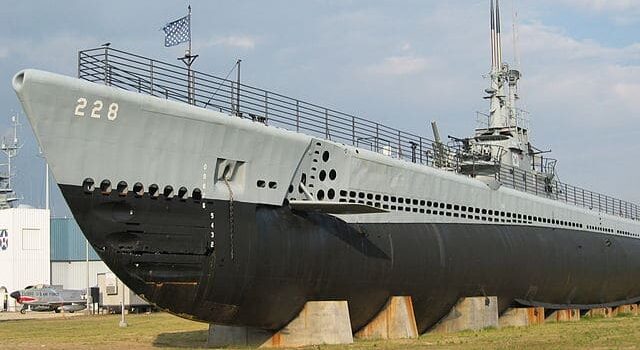
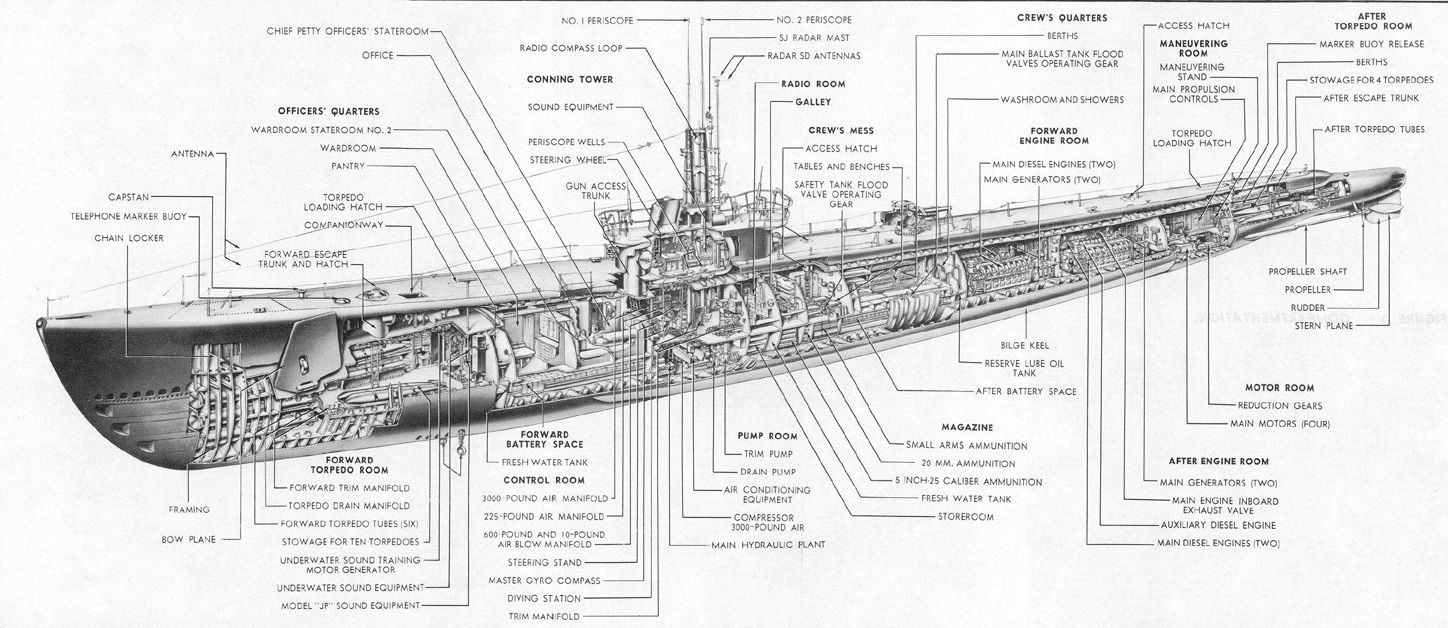
 Latest Facebook Entry -
Latest Facebook Entry -  X(Tweeter) Naval Encyclopedia's deck archive
X(Tweeter) Naval Encyclopedia's deck archive Instagram (@navalencyc)
Instagram (@navalencyc)





 French Navy
French Navy Royal Navy
Royal Navy Russian Navy
Russian Navy Armada Espanola
Armada Espanola Austrian Navy
Austrian Navy K.u.K. Kriegsmarine
K.u.K. Kriegsmarine Dansk Marine
Dansk Marine Nautiko Hellenon
Nautiko Hellenon Koninklije Marine 1870
Koninklije Marine 1870 Marinha do Brasil
Marinha do Brasil Osmanlı Donanması
Osmanlı Donanması Marina Do Peru
Marina Do Peru Marinha do Portugal
Marinha do Portugal Regia Marina 1870
Regia Marina 1870 Nihhon Kaigun 1870
Nihhon Kaigun 1870 Preußische Marine 1870
Preußische Marine 1870 Russkiy Flot 1870
Russkiy Flot 1870 Svenska marinen
Svenska marinen Søværnet
Søværnet Union Navy
Union Navy Confederate Navy
Confederate Navy Armada de Argentina
Armada de Argentina Imperial Chinese Navy
Imperial Chinese Navy Marinha do Portugal
Marinha do Portugal Mexico
Mexico Kaiserliche Marine
Kaiserliche Marine 1898 US Navy
1898 US Navy Sovietskiy Flot
Sovietskiy Flot Royal Canadian Navy
Royal Canadian Navy Royal Australian Navy
Royal Australian Navy RNZN Fleet
RNZN Fleet Chinese Navy 1937
Chinese Navy 1937 Kriegsmarine
Kriegsmarine Chilean Navy
Chilean Navy Danish Navy
Danish Navy Finnish Navy
Finnish Navy Hellenic Navy
Hellenic Navy Polish Navy
Polish Navy Romanian Navy
Romanian Navy Turkish Navy
Turkish Navy Royal Yugoslav Navy
Royal Yugoslav Navy Royal Thai Navy
Royal Thai Navy Minor Navies
Minor Navies Albania
Albania Austria
Austria Belgium
Belgium Columbia
Columbia Costa Rica
Costa Rica Cuba
Cuba Czechoslovakia
Czechoslovakia Dominican Republic
Dominican Republic Haiti
Haiti Hungary
Hungary Honduras
Honduras Estonia
Estonia Iceland
Iceland Eire
Eire Equador
Equador Iran
Iran Iraq
Iraq Latvia
Latvia Liberia
Liberia Lithuania
Lithuania Mandchukuo
Mandchukuo Morocco
Morocco Nicaragua
Nicaragua Persia
Persia San Salvador
San Salvador Sarawak
Sarawak Uruguay
Uruguay Venezuela
Venezuela Zanzibar
Zanzibar Warsaw Pact Navies
Warsaw Pact Navies Bulgaria
Bulgaria Hungary
Hungary

 Bundesmarine
Bundesmarine Dutch Navy
Dutch Navy Hellenic Navy
Hellenic Navy Marina Militare
Marina Militare Yugoslav Navy
Yugoslav Navy Chinese Navy
Chinese Navy Indian Navy
Indian Navy Indonesian Navy
Indonesian Navy JMSDF
JMSDF North Korean Navy
North Korean Navy Pakistani Navy
Pakistani Navy Philippines Navy
Philippines Navy ROKN
ROKN Rep. of Singapore Navy
Rep. of Singapore Navy Taiwanese Navy
Taiwanese Navy IDF Navy
IDF Navy Saudi Navy
Saudi Navy Royal New Zealand Navy
Royal New Zealand Navy Egyptian Navy
Egyptian Navy South African Navy
South African Navy






























 Ukrainian Navy
Ukrainian Navy dbodesign
dbodesign
Nice info
How long did it take to reload a torpedo tube? What about all six bow tubes in a World-War II era boat?
I saw numbers down to a minute by torpedo for a very well drilled crew to 40 min. for a full set internally, but that depends on the conditions beyond the crew, ie pitching/rolling/silence asked, depth charged… ect. Before the Type XXI it was tedious, dangerous gantry/chain/pulley affair. This is not the same as loading a full set surfaced at port or at sea. U-Boats had a deck hatch shwn in photos for this. Other subs loaded their torpedoes by the tubes.